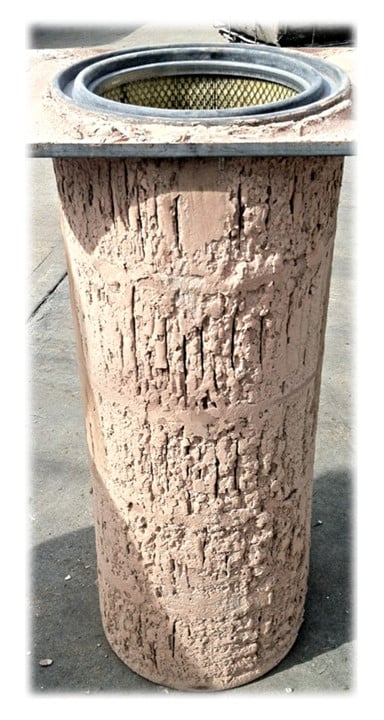A simple dust collection system is composed of the exhaust fan, dust collector (cyclone, baghouse, cartridge collector, wet scrubber, etc.), ductwork, and hoods. An issue with one of these components could cause your dust collection system to fail or not work as designed. However, the dust collector is usually the most complex component and the most likely to develop issues, but is often the most neglected. Just like an automobile, proper maintenance of a dust collector could save a whole lot of issues in the future.
A variety of issues can develop in the operation of dust collectors. We will discuss baghouses specifically, but cartridge collectors have very similar issues, while cyclones and wet scrubbers have their own set of items that need attention.
Plugged filters. Bag Filters are the primary component in dust collection. If they aren’t operating correctly, the dust collection will not be operating properly. The filters can fail if they get plugged up or develop holes. When plugged up, they will not let the proper amount of air through, which will cause the airflow through the system to decline; thereby, picking up less dust at the pickup points. Plugged filters can be spotted by monitoring the pressure drop across the bags or noticing less air movement at the pickup points. When filters are plugged up, they should be replaced and quickly.
Holes in the bag filters allow dust past the filters; thereby, decreasing the removal efficiency in the system. This can cause you to violate your EPA permit, cause damage to the exhaust fan and/or cause issues with the neighbors. Holes in the filters can be spotted by bag break monitors, stack testing, or noticing dust in the exhaust. When bags are broken they should be replaced, however, it is often difficult to identify which bag has the hole so often times multiple (if not all) bags should be replaced.
Inspect these other components. Baghouses also contain many supplementary items that help them operate effectively. These can also develop issues which causes the system to fail. These items include solenoid valves, poppet valves, control panel, bag support cages and venturi, diffuser, hopper and airlocks. These items should be inspected, cleaned and components replaced if necessary.
Other factors to consider: Failure in the cleaning system will cause high pressure drop. Damage to the cages could cause holes in the bags. Damage to the diffuser will cause some bags to plug up faster than others. Damage to the hopper or excess dust in the hopper will cause higher dust concentrations that decreases removal efficiency. An inoperative or inappropriate airlock will cause dust build up in the hopper and/or air leakage.
A yearly inspection of your baghouse will help you identify these issues before they develop. This will help your dust collection system operate at peak efficiency and as it was designed. And as with your automobile, preventative maintenance ends up saving you money in the long run. If your baghouse stops operating you will have to do an emergency repair or, as is most often the case, it will gradually decrease in its efficiency without you noticing. You will then be wasting your money on operating a system that isn’t effective. And if you are inspected, you could be fined.
If you are having operational issues on your dust collection system, contact Aerodyne at 440-543-7400 or dc@dustcollectorhq.com or click the button below.


